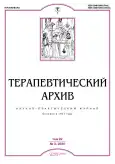Comparative analysis of the strength of the respiratory muscles in community-acquired pneumonia with different severity of endogenous intoxication
- Authors: Geltser B.I.1, Dej A.A.1, Titorenko I.N.1, Kotelnikov V.N.1
-
Affiliations:
- Far Eastern Federal University
- Issue: Vol 92, No 3 (2020)
- Pages: 19-24
- Section: Editorial article
- URL: https://journals.rcsi.science/0040-3660/article/view/33888
- DOI: https://doi.org/10.26442/00403660.2020.03.000372
- ID: 33888
Cite item
Full Text
Abstract
Aim. To assess the strength of the respiratory muscles in patients with community-acquired pneumonia (CAP) with varying severity of endogenous intoxication.
Materials and methods. In the hospital, 78 men aged 18–26 years with CAP were examined. СAP was diagnosed in 56 (72%) patients, severe CAP in 22 (28%). The severity of endogenous intoxication was verified using intoxication indices: hematological index of intoxication (HII), leukocyte index of intoxication (LII), nuclear index of intoxication (NII) and Krebs index. Middleweight molecules (MWM) was determined by spectrophotometry in the serum and the concentration of interleukin (IL)-10 and tumor necrosis factor (TNF-) by ELISA. The strength of the respiratory muscles was measured on the device Micro RPM (Care Fusion, Great Britain). The maximum expiratory pressure (МЕР), inspiratory pressure (MIP) in the oral cavity, the Maximal Rate of Pressure Development (MRPD) during inhalation (MRPDin) and exhalation (MRPDex), and intranasal test (SNIP) were determined. Statistical processing was performed using descriptive statistics, Mann–Whitney test, correlation and cluster analysis.
Results. Three clusters of endogenous intoxication corresponding to mild, moderate and severe degree were identified. The first cluster was represented only by patients with mild CAP, the second-mild CAP and severe CAP, and the third – severe CAP. Dysfunction of the expiratory respiratory muscles prevailed during the height of the disease in patients with the first cluster, and in the second and third inspiratory, including the diaphragm. The level of actually measured values of MIP and SNIP was 68% and 58% of those due to severe endogenous intoxication. Significant negative correlations were established LII, HII, MWM, TNF-, IL-10 с MEP, MRPDex, MIP и SNIP. Respiratory muscle dysfunction remained only expiratory respiratory muscles in convalescents of the first cluster, and expiratory and inspiratory muscles of the second and third cluster.
Conclusion. The development of respiratory muscle dysfunction in CAP is associated with the influence of endogenous intoxication factors. The results can be used in personalized programs of rehabilitation.
Full Text
##article.viewOnOriginalSite##About the authors
B. I. Geltser
Far Eastern Federal University
Author for correspondence.
Email: Geltser@vvsu.ru
ORCID iD: 0000-0002-9250-557X
чл.-кор. РАН, д.м.н., проф., директор департамента клинической медицины
Russian Federation, VladivostokA. A. Dej
Far Eastern Federal University
Email: Geltser@vvsu.ru
ORCID iD: 0000-0003-2626-412X
аспирант Школы биомедицины
Russian Federation, VladivostokI. N. Titorenko
Far Eastern Federal University
Email: Geltser@vvsu.ru
ORCID iD: 0000-0002-1926-5274
аспирант Школы биомедицины
Russian Federation, VladivostokV. N. Kotelnikov
Far Eastern Federal University
Email: Geltser@vvsu.ru
ORCID iD: 0000-0001-5830-1322
д.м.н., проф. департамента клинической медицины
Russian Federation, VladivostokReferences
- Бородин Е.А., Егоршина Е.В., Самсонов В.П. Биохимия эндотоксикоза. Механизмы развития и оценка степени тяжести при воспалительных заболеваниях легких. Благовещенск: АГМА, 2003 [Borodin EA, Egorshina EV, Samsonov VP. Biochemistry of endotoxemia. Development mechanisms and severity assessment in inflammatory lung diseases. Blagoveshchensk: AGMA, 2003 (In Russ.)].
- Котельников В.Н., Карпенко А.А., Ким А.П., Гельцер Б.И. Ультраструктурные АСМ-маркеры эндогенной интоксикации при внебольничной пневмонии. Современные технологии в медицине. 2017;9(2):53-60 [Kotelnikov VN, Karpenko AA, Kim AP, Geltser BI. Ultrastructural AFM markers of endogenous intoxication in community-acquired pneumonia. Sovremennye tekhnologii v medicine. 2017;9(2):53-60 (In Russ.)]. doi: 10.17691/stm2017.9.2.06
- Авдеев С.Н. Оценка силы дыхательных мышц в клинической практике. Практическая пульмонология. 2008;4:2-17 [Avdeev SN. Evaluation of the strength of the respiratory muscles in clinical practice. Prakticheskaya pul’monologiya. 2008;4:2-17 (In Russ.)].
- Kaminska M, Noel F, Petrof BJ. Optimal method for assessment of respiratory muscle strength in neuromuscular disorders using sniff nasal inspiratory pressure (SNIP). PloS One. 2017;12(5):e0177723. doi: 10.1371/journal.pone.0177723
- Kulnik ST, Rafferty GF, Birring SS, et al. A pilot study of respiratory muscle training to improve cough effectiveness and reduce the incidence of pneumonia in acute stroke: study protocol for a randomized controlled trial. Trials. 2014;15:123-33. doi: 10.1186/1745-6215-15-123
- Гельцер Б.И., Дей А.А., Титоренко И.Н., Котельников В.Н. Оценка силы дыхательных мышц при внебольничной пневмонии. Военно-медицинский журнал. 2018;339(11):27-33 [Geltser BI, Day AA, Titorenko IN, Kotelnikov VN. Evaluation of the strength of the respiratory muscles in community-acquired pneumonia. Voenno-medicinskij zhurnal. 2018;339(11):27-33 (In Russ.)].
- Чучалин А.Г., Синопальников А.И., Козлов Р.С. и др. Клинические рекомендации по диагностике, лечению и профилактике тяжелой внебольничной пневмонии у взрослых. Пульмонология. 2014;4:13-48 [Chuchalin AG, Sinopalnikov AI, Kozlov RS, et al. Clinical recommendations for the diagnosis, treatment and prevention of severe community-acquired pneumonia in adults. Pul’monologiya. 2014;4:13-48 (In Russ.)]. doi: 10.18093/0869-0189-2014-0-4
- Гельцер Б.И., Шахгельдян К.И., Курпатов И.Г., Котельников В.Н. Результаты моделирования должных величин силы дыхательных мышц на основе метода искусственных нейронных сетей. Российский физиологический журнал им. И.М. Сеченова. 2018;104(9):1065-74 [Geltser BI, Shahgeldyan KI, Kurpatov IG, Kotelnikov VN. The results of modeling the proper values of the strength of the respiratory muscles based on the method of artificial neural networks. Rossijskij fiziologicheskij zhurnal im. I.M. Sechenova. 2018;104(9):1065-74 (In Russ.)]. doi: 10.7868/S0869813918090058
- Wehrens R, Buydens L. Self- and Super-organizing Maps in R: The kohonen Package. J Statistical Software. 2007;21(5). doi: 10.18637/jss.v021.i05
- Rijkers GT, Holzer L, Dusselier T. Genetics in community-acquired pneumonia. Curr Opin Pulm Med. 2019;25(3):323-9. doi: 10.1097/MCP.0000000000000580
- Александрова Н.П. Цитокины и резистивное дыхание. Физиология человека. 2012;38(2):119 [Alexandrova NP. Cytokines and Resistive Respiration. Fiziologiya cheloveka. 2012;38(2):119 (In Russ.)].
- Гельцер Б.И., Курпатов И.Г., Дей А.А., Кожанов А.Г. Дисфункция респираторных мышц и болезни органов дыхания. Терапевтический архив. 2019;91(3):93-100 [Geltser BI, Kurpatov IG, Day AA, Kozhanov AG. Respiratory muscle dysfunction and respiratory disease. Therapeutic Archive. 2019;91(3):93-100 (In Russ.)]. doi: 10.26442/00403660.2019.03.000108
- Kabitz HJ, Walterspacher S, Mellies U, et al. Recommendations for respiratory muscle testing. Pneumologie. 2014;68(5);307-14. doi: 10.1055/s-0034-1365283
- Тетенев Ф.Ф., Агеева Т.С., Даниленко В.Ю., Дубаков А.В. Пиковая скорость выдоха и бронхиальное сопротивление у пациентов с внебольничной пневмонией. Сибирский медицинский журнал. 2005;58(8);43-5 [Tetenev FF, Ageeva TS, Danilenko VYu, Dubakov AV. Peak expiratory flow rate and bronchial resistance in patients with community-acquired pneumonia. Sibirskij medicinskij zhurnal. 2005;58(8);43-5 (In Russ.)].
Supplementary files







